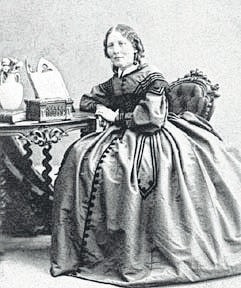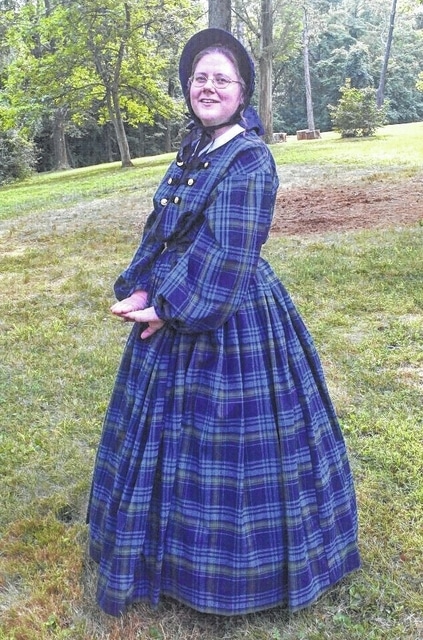

SIDNEY — When President Abraham Lincoln met Harriett Beecher Stowe at a White House reception on November 25, 1862, he is reported to have greeted her with the remark: “So you are the little lady who started this big war!” Stowe, the author of more than 30 books, is best known for her portrayal of the lives of slaves in her novel, “Uncle Tom’s Cabin.”
Stowe, through the person of Dana Gagnon, will be one of the individuals appearing at Sidney’s Civil War Living History Weekend. Gagnon, currently a member of the staff of Heritage Village Museum (Cincinnati), will do a first-person impression of Harriet Beecher Stowe on both Saturday and Sunday of Sidney’s two-day event.
Gagnon, who has been participating in living history events for more than fourteen years, has portrayed Harriet Beecher Stowe since 2012.
“We have a lot in common,” Gagnon stated. “We are both teachers, we are both New Englanders and we were both transplanted to Cincinnati,” she said with a smile.
“One of the great things about doing an impression of Stowe is that you don’t have to imagine what she was thinking about any topic. She wrote it down and her family saved her voluminous correspondence, much of which has been published. It is so easy to immerse oneself in her character,” Gagnon said.
“At the end of each presentation, I answer questions,” Gagnon said. “People today are still asking the same kinds of questions they were asking in 1860 – and it’s 150 years later!”
“So many people have not read ‘Uncle Tom’s Cabin’,” Gagnon stated. “They think they know what the book is about because of what they’ve been told. When people read it for the first time, the reaction is always the same – the book is not what people expect. The depth of the characters in the book is remarkable.”
Harriet Elisabeth Beecher was born in Litchfield, Connecticut, on June 14, 1811. She was the seventh of 13 children born to outspoken Calvinist preacher Lyman Beecher and Roxana (Foote), a deeply religious woman who died when Stowe was only five years old.
Harriet enrolled in the Hartford Female Seminary run by her older sister Catharine, where she received a traditional academic education usually reserved for males at the time. There was a focus in the classics, including study of languages and mathematics.
In 1832, at the age of 21, Harriet Beecher moved to Cincinnati, Ohio, to join her father, who had become the president of Lane Theological Seminary. There, she also joined the Semi-Colon Club, a literary salon and social club whose members included the Beecher sisters, Caroline Lee Hentz, a novelist opposed to the abolitionist movement, Salmon P. Chase, future governor of Ohio, Secretary of Treasury, and Chief Justice of the Supreme Court, Elizabeth Blackwell, the first American female physician, Judge James Hall, editor of Western Monthly Magazine, pioneering physician Daniel Drake, founder of the University of Cincinnati Medical School, and other luminaries of the time.
Cincinnati’s trade and shipping business on the Ohio River was booming. The boom drew numerous migrants from different parts of the country, including many free blacks. Irish immigrants, who found work on the state’s canals and railroads, had also moved into the city in large numbers.
Areas of the city had been wrecked in the Cincinnati riots of 1829, when ethnic Irish attacked blacks, trying to push competitors out of the city. Beecher met a number of African Americans who had suffered in those attacks, and their experience contributed to her later writing about slavery.
There were subsequent riots in 1836 and 1841. Those riots served to reinforce Stowe’s earlier conversations with blacks who had suffered from the hatred and bigotry that had been unleashed during the tumult.
It was in the literary club that she met Calvin Ellis Stowe, a widower who was a professor at the seminary. The two married on Jan. 6, 1836. He was an ardent critic of slavery, and the Stowes supported the Underground Railroad. They unknowingly gave employment to an escaped slave. One day their servant came home terrified having seen her former master in the city. The Stowes immediately moved her to the home of John VanZandt, a known stop on the Underground Railroad.
In 1850, Congress passed the Fugitive Slave Law, prohibiting assistance to fugitives and strengthening sanctions even in free states. At the time, Stowe had moved with her family to Brunswick, Maine, where her husband was now teaching at Bowdoin College.
Stowe claimed to have had a vision of a dying slave during a communion service in the college chapel, which inspired her to write his story. On March 9, 1850, Stowe wrote to Gamaliel Bailey, editor of the weekly antislavery journal National Era that she planned to write a story about the problem of slavery: “I feel now that the time is come when even a woman or a child who can speak a word for freedom and humanity is bound to speak… I hope every woman who can write will not be silent.”
Shortly after, in June 1851, when she was 40, the first installment of “Uncle Tom’s Cabin” was published in serial form in the newspaper National Era. She originally used the subtitle “The Man That Was A Thing,” but it was soon changed to “Life Among the Lowly”.
Installments were published weekly from June 5, 1851, to April 1, 1852. For the newspaper serialization of her novel, Stowe was paid $400. Uncle Tom’s Cabin was published in book form on March 20, 1852, by John P. Jewett with an initial print run of 5,000 copies. In less than a year, the book sold an unprecedented 300,000 copies.
The book had dual goals. It attempted to educate northerners on the realistic horrors of the things that were happening in the south. Stowe also hoped that her book would make people in the south feel more empathetic toward the people they were forcing into slavery.
“The book was so much more,” stated Gagnon. “To southerners, Stowe illustrates that even slaves with kind owners and preferred assignments cannot control their own families or destiny—only freedom will allow that. And to northerners, she challenges them that simply not approving is not the same as action, and not the same as personal involvement.”
The book’s emotional portrayal of the effects of slavery on individuals captured the nation’s attention. Stowe showed that slavery touched all of society, beyond the people directly involved as masters, traders and slaves. Her novel added to the debate about abolition and slavery, and aroused opposition in the South.
Gagnon, through her portrayal of Stowe, will talk about being a mother, a wife and of course, will discuss the most famous of her books, Uncle Tom’s Cabin. She will speak in the Education Tent near the civilian camp on both Saturday and Sunday. Her presentation on Saturday will be at 1 p.m. Her presentation on Sunday will be at 11:30 a.m.
In addition to being on staff at Heritage Village Museum, she is a member of the Ladies Living History Society of Greater Cincinnati and the coordinator for the Western Female Seminary Living History Society. Gagnon has lived in Ohio for more than ten years. She has participated in historical events at Heritage Village in Sharon Woods, the Cincinnati Museum Center, the Taft birth home, Ohio Village (Columbus), Caesar Creek’s Pioneer Village, and Battery Hooper at the James Ramage Civil War Museum in Kentucky.
Although no Civil War battles were fought anywhere near Sidney, a considerable number of local men served in the Union Army during the Civil War. In fact, the 1860 Census records that Shelby County had a population of 17,493. Of that number 8960 were male, and a staggering 14 percent of them served in the Army during the war. Of those, 25.58 percent (326) died in the service of their country.
The Civil War Living History Weekend is slated to be held in Tawawa Park Sept. 17-18. The two-day event will include skirmishing between Confederate and Union troops, major battles fought both days, a number of educational presentations, a band concert Saturday evening, and church services Sunday morning. The event is being co-sponsored by the Shelby County Historical Society and the City of Sidney.



